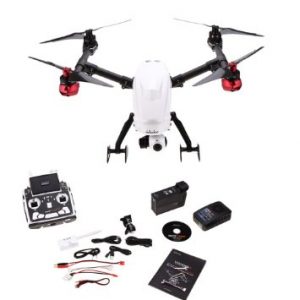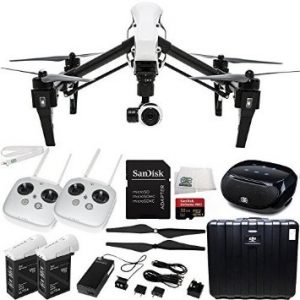Inspire 1 vs. the Voyager 3: Who Wins?
The last thing you want when buying a not-so-affordable drone is to get one that’s not worth the price. You only want the best, but with so many choices available, figuring out which one to get takes a little effort.
Walkera Voyager 3 Dual-Navigation RC Quadcopter FPV With 4K Camera DEVO F12E RTF
When it comes to aerial photography drones, for example, two of the top names that always come up are the Walkera Voyager 3 and the DJI Inspire 1. Many drone reviews pit the two against each other, and from the looks of it, they look like to be worthy opponents. Here, we pit the Walkera Voyager 3 vs DJI Inspire 1 and see which one is the better bird.
DJI Inspire 1 vs. Walkera Voyager 3 Specifications
When it comes to the little details, the Inspire 1 and the Voyager 3 have a lot of similarities, but the Walkera unit sails past the DJI unit just a little. The Voyager 3 lasts longer in the air and is a little bigger, but the Inspire is lighter and more agile.
Build
Go through a few Walkera Voyager 3 reviews and one thing that stands out when it comes to looks is its uncanny resemblance to the DJI Inspire 1. Right off the bat, you’d think it’s a bigger Inspire 1.
DJI T600 Inspire 1 Quadcopter with 4k Video Camera with Controller
Due to its bigger size, the Voyager 3 looks a bit stronger, as the fixings and transmutable skids are made from CNC material. Durability is not a problem for both drones, though. The Inspire 1 comes with its own impressive protection, with carbon fiber parts in the landing gear. This gives the unit toughness without adding too much weight. Both have sleek and futuristic designs without being over the top. The Voyager 3 does have a wider body frame compared to the Inspire 1, but it’s a non-issue.
Battery
The Voyager 3 edges out the Inspire 1 when it comes to battery and flight time, with the Walkera unit able to stay in the air about 7 minutes longer than the DJI drone. In reality, of course, the time you can play with these UAVs depend on wind conditions, weather, and other factors.
The battery life for both units, however, is commendable considering their size and build. Although we wish it could be longer, the more than 15 minutes of flight time is already a plus, even amid the occasional gusts.
Camera
As for cameras, any of the two is a great buy if you’re looking for a quadcopter for aerial filming. The Inspire 1 and Voyager 3 have a built-in 4k camera mounted on a 3-axis gimbal that can rotate 360-degrees.
Both birds can record 4k videos at 30fps and 1080p clips at 60fps, but the Voyager 3 soars just a bit higher than the Inspire thanks to its more vibrant shades and slightly better sharpness.
The improvement in Inspire 1’s camera, however, is worth a special mention, as it is more than a few steps ahead of the Phantom 2 Vision+. Moreover, the camera is detachable, which means future upgrades will only need a simple unscrewing of the old cam.
The gimbal is also worth praise, as it uses the same 3-axis gimbal technology DJI is famous for. The gimbal in Inspire 1 is more stable than the one on the Voyager 3, and it can rotate 360-degrees and tilt up to 125-degrees—something no other drone can match to date.
When it comes to first person view, the Inspire 1 is the high flyer, with its Lightbridge HD FPV. The Voyager 3 only has the standard FPV setup.
Navigation
As for flight controllers, Walkera is introducing an APM-based technology with the Voyager 3. If simplified, the controller can certainly do a lot in improving the quad’s navigation with GPS waypoint capabilities and ‘circle me’ and ‘follow me’ features.
DJI is not backing down, though, as it gives us a machine that’s incredibly easy to fly with the Inspire 1. The company’s Vision+ Drone already made a name for its easy navigability. The Inspire 1 soars above that with its intuitive controller and app interface. Add to that the drone’s ability to stay put even with gusts and Inspire 1 comes out the winner in this category.
The Verdict
Based on several DJI Inspire 1 reviews, if there’s one thing that can drag the Inspire 1 down, it’s the price tag. Both quads feature similar, sleek designs and impressive features, but Walkera is beating DJI on price.
At the end of the day, in the fight of the Walkera Voyager 3 vs DJI Inspire 1, it’s really up to you. If you want affordability, the Walkera drone is for you. But if you’re willing to pay extra for a few more impressive specs and features, then the DJI unit is the right choice. One thing’s for sure: both are impressive and are a lot of fun.


There are no comments yet, add one below.